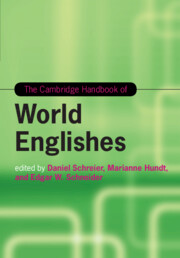Book contents
- The Cambridge Handbook of World Englishes
- Cambridge Handbooks in Language and Linguistics
- The Cambridge Handbook of World Englishes
- Copyright page
- Dedication
- Contents
- Figures
- Maps
- Tables
- Notes on Contributors
- 1 World Englishes: An Introduction
- Part I The Making of Englishes
- Part II World Englishes Old and New
- 7 A Sociolinguistic Ecology of Colonial Britain
- 8 English in North America
- 9 English in the Caribbean and the Central American Rim
- 10 English in Africa
- 11 English in South Asia
- 12 English in Southeast Asia
- 13 World Englishes Old and New: English in Australasia and the South Pacific
- Part III Linguistics and World Englishes
- Part IV Current Challenges
- Index
- References
8 - English in North America
from Part II - World Englishes Old and New
Published online by Cambridge University Press: 16 December 2019
- The Cambridge Handbook of World Englishes
- Cambridge Handbooks in Language and Linguistics
- The Cambridge Handbook of World Englishes
- Copyright page
- Dedication
- Contents
- Figures
- Maps
- Tables
- Notes on Contributors
- 1 World Englishes: An Introduction
- Part I The Making of Englishes
- Part II World Englishes Old and New
- 7 A Sociolinguistic Ecology of Colonial Britain
- 8 English in North America
- 9 English in the Caribbean and the Central American Rim
- 10 English in Africa
- 11 English in South Asia
- 12 English in Southeast Asia
- 13 World Englishes Old and New: English in Australasia and the South Pacific
- Part III Linguistics and World Englishes
- Part IV Current Challenges
- Index
- References
Summary
The many-faceted history of English in North-America has proved a challenge for accounts of the subsequent development of an old language in a new geographical setting. The complexity of the parameters involved has led researchers to engage in language theory and empirical work in various disciplinary traditions, among them dialectology, historical sociolinguistics and corpus linguistics. The recent electronic resources and interest in texts written by less educated authors have enabled researchers to ask new questions and re-visit old ones from a fresh perspective. This chapter focuses on the intriguing paths of development of varieties such Anglo-American Englishes, Canadian English, and African American English. It pays attention to processes of change and the role played by e.g. contact phenomena in the life cycles of the varieties. Linguistic conservatism and innovation create tension in the new sociodemographic environment of an emerging variety, promoting or discouraging unification or diversification tendencies. The linguistic features investigated across the varieties in the chapter comprise phonetic and phonological features, morphosyntax, grammar, and vocabulary.
Keywords
- Type
- Chapter
- Information
- The Cambridge Handbook of World Englishes , pp. 160 - 184Publisher: Cambridge University PressPrint publication year: 2020



